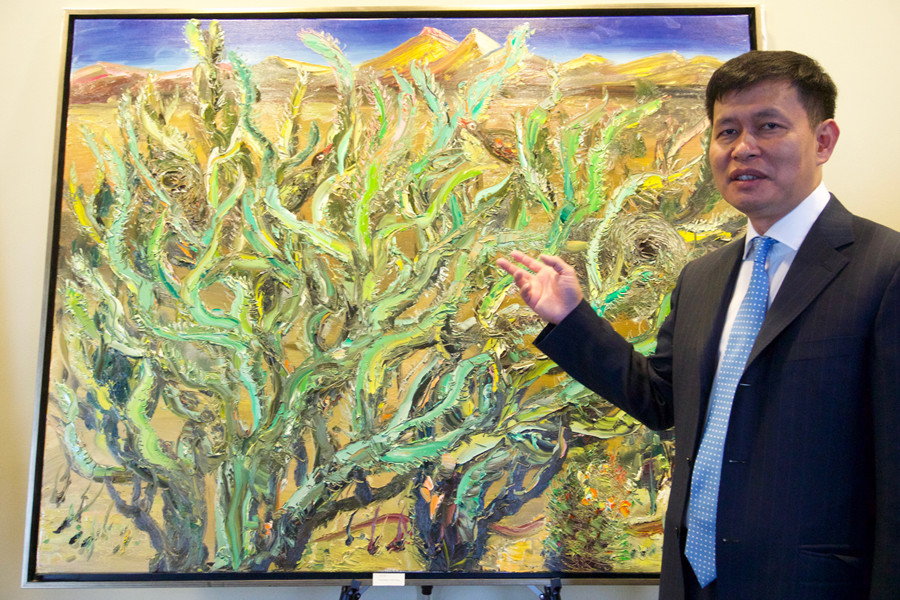Oil painter does his part for humanity
 0 Comment(s)
0 Comment(s) Print
Print E-mail China Daily, November 1, 2018
E-mail China Daily, November 1, 2018

After touring the United States for 40 days to sketch wild landscapes, artist Zhou Changxin created 37 oil paintings, depicting the magnificent mountains and rivers of the United States. They recently went on display at United Nations headquarters in New York.
"Through my observation and then my brushwork of the mountains, rivers, plants and flowers in the US, I wanted to express the coexistence of men and other living beings, to call for human beings to work together to protect our home, which is already fragile," Zhou explained on Oct. 19 at the opening of the exhibit Dynamic Life, Rainbow Colors.
"As we all know, at present, the multipolarization of the world is being challenged unprecedentedly. The international order, on which human beings depend, is gradually disintegrating," he said.
"So, I think it's time to let my voice be heard though art," he added.
Zhou visited 10 states from the West Coast to the East.
"I traveled to Wyoming, Montana, Idaho, Arizona and Nevada to capture scenes and sights like Yellowstone Park and the Grand Canyon," he said.
"And others I made based on scenes in the Catskills of New York and Niagara Falls," he told China Daily.

Zhou said he felt blessed to travel to the Catskills and the Hudson Valley, as the scenery there was featured in paintings by Thomas Cole (1801-1848), the English-born American painter known for his romantic paintings of the American wilderness.
This exhibition is the seventh stop on the worldwide tour of Zhou's exhibition. Over the past 10 years, the show has been mounted in Italy, France, Germany, Belgium and the Netherlands.
In May, Zhou had a large one-man show at the National Museum of China in Beijing.
As a renowned contemporary Chinese artist, Zhou is known for combining creativity with the beauty of the wilderness. The contemporary Chinese artist is also well known for his invention — zhong cai oil painting.
All of the works on display at the UN exhibition are zhong cai oil paintings.
Zhong cai, which means "heavy color" in Chinese, is considered one of the two most important painting styles of traditional Chinese painting, along with ink.
A Thousand Miles of Rivers and Mountains by Wang Ximeng of the Song Dynasty (960-1127), now displayed in the Palace Museum, is considered the pinnacle of zhong cai.
From the late 1980s to early 1990s, after Chinese-American artist Ting Shao Kuang introduced Chinese zhong cai painting to the US, it became popular globally. In its prime, Chinese zhong cai was considered noble and fashionable by American families.
After years of study and practice, Zhou concluded that Chinese zhong cai is lacking when it comes to molding figures and expressing national spirit.
"The creativity of Chinese painting is facing serious problems," he declared.
However, "zhong cai oil painting is a brand new form in contemporary China born out of the happy marriage of Chinese and Western art," Zhou explained.
"Oil in form and Chinese in elements, it is a powerful and free-hand genre in oil painting, highly expressive and unlimited," he said. "I would like to compare zhong cai oil painting to a product of oil art globalization, an expression of Chinese art to the world."
"The invention of zhong cai oil painting is more than just of academic significance. It is an artistic idea, an attitude toward culture," said Shui Tianzhong, fellow of the Chinese National Academy of Arts.

"This idea is base on his strong confidence in the vitality of Chinese culture, in the through knowledge and profound study of Chinese and Western art," Shui wrote.
Born in 1973 in Zhanjiang, Guangdong province in South China, Zhou graduated from the Art School of Zhanjiang in 1993. In 1994, he began to study modern zhong cai at the Central Academy of Fine Arts (now the art school of Tsinghua University) in Beijing and was admitted into its graduate school as a mural painting major in 2000.
Zhou, currently the dean of the Changxin International Art School at Yunnan University and honorary chairman of the Zhou Changxin Art Fund, is active in promoting cross-cultural exchanges apart from painting.
"Both the Eastern arts and the Western arts have their own strengths. It's necessary that the East and the West communicate often, to learn from each other's strengths, and to develop together," Zhou said.
"I hope the United Nations as a vehicle for human progress could open up more space for artists from all over the world to showcase their artworks, to exchanges ideas and to promote arts to a higher and better direction in the future," he said.






Go to Forum >>0 Comment(s)